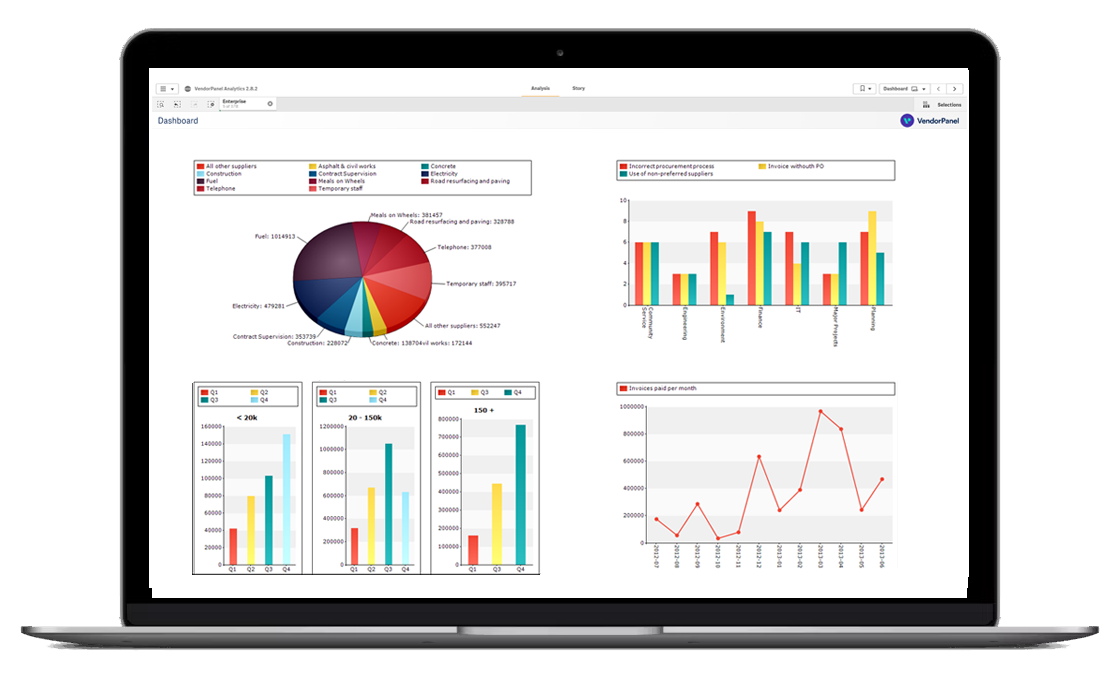
Policy Guide

Procurement Planning

Supplier Discovery

Supplier Management

Go To Market

Compliance Management

Evaluation & Award

Contract Management

Reporting & Analytics
See an overview of all the procurement modules.

Customer Experience

Flexible Ecosystem

World Class Security
See why customers choose the VendorPanel Platform.
Solutions
Mia McCaskie | 16 May 2022 | 4 min read
Why You Need Data Analytics in Procurement and Contract Management

Business intelligence is one of the most valuable resources for leaders today. In this article, we will look at how data analytics plays a key role in procurement and contract management and why you need integrated reporting tools.
What is Procurement Analytics?
Procurement analytics is about gathering data from all the sources that affect the procurement activities in an organisation. It involves using analytics tools to gain insights, track performance, spot trends and plan ahead.
To give this ‘sea of data’ meaning, you can create visual reports using procurement analytics software which the procurement team can then use to make informed business decisions.
The solution gathers this data from various sources both within and without an organisation, such as spend and transactional data, supplier credit ratings and contract performance.
The Benefits of Procurement Data Analytics
The bottom line is that without analysis, data is just data, and it only becomes valuable if turned into actionable insights where you can see:
- what is happening
- why it’s happening
- how to take better actions
“Every business is a data business.” Heidi Custers, Digital Transformation Strategy Manager, Deloitte
Here are five benefits to consider:
1. Procurement and contract data analytics enable data-driven decisions
By getting strategic insights from the data, this promotes better business management. For example:
- It gives you a better understanding of how your business is performing.
- It shows you what’s working and what’s not.
- It enables you to plan better using predictive analysis.
- It allows you to better manage your contracts (If you have contract analytics.)
- It helps improve strategic sourcing.
2. Real-time data is displayed instantly
Now more than ever, business leaders must swiftly act on opportunities, and real-time data is becoming the best way to improve governance and reduce risk. In comparison, traditional reporting methods often fall short as they are time-consuming and present static data. After all, data in your spreadsheet needs to be manually updated, but an analytics tool will crawl it for you.
3. Cover a broad scope with integrated data
Integrated data gives a look into your overall business performance, which is useful for seeing the complete picture of your organisation. This is especially true when you integrate it with your financial software.
For example, you can take the data from your Safety Management solution, showing the number of safety incidents linked to certain contractors, and combine this data with information from your Contract Management solution. Now you can see which contractors are most likely to have safety incidents while delivering contracts. This will then help you to be more strategic with your procurement and contract strategy.
4. Gain transparency into how your money is being spent
The procurement data allows you to see what’s going on with your financials. It uncovers unusual spend, such as maverick spending, and points out where savings can be found. This information also reveals where your revenue is coming from and where it is going.
5. Risk management
To mitigate the risks around your procurement and contracts, you need to understand what your data is telling you and this can only be done with proper data tools. Although nobody can predict every possible risk, having the data logically presented helps you to think creatively about how to manage your procurement wisely.
Examples of Procurement and Contract Data Reports
Firstly, the reporting tool garners data from various internal and external sources. Most of the information would come from a Procurement and Contract Management solution, or a full Source-to-Pay system, with third-party sources such as a financial system included in the mix.
The reports themselves can be out-of-the-box standard reports or designed to suit each organisation’s needs.
Most solutions have a dashboard that can give you a complete visual overview of all your activities, with drill-down reporting to underlying data.

Examples:
- Supplier Reports, e.g., Supplier Performance Indicators, Supplier Ratings, Supplier Credit Scores
- Contract Management tracking and monitoring, e.g., Contract KPIs, Contract Expiry, Contract Variations, Contract Values, Contract Milestones
- Procurement Spend Analysis, e.g., Budget vs Actual Spend, Savings, Spend by Category, Sourcing Values
- RFx Analytics, e.g., RFx Status, Number of Requests by Month
- Risk Analysis Reports
- Payment Terms
- Benchmarking
- Insurance Report
Questions to Ask About Data Analytics Tools
To make data analytics work, you need the right tools. There are many sophisticated options out there, and nowadays, most Source-to-Pay solutions come ready with some level of reporting ability.
If you are investing in Procurement and Contract Management software, you need to ask questions like:
- Does the software platform have reporting, charts and dashboards that are configurable to the requirements of my company?
- Does it integrate with my company’s other systems to supply a holistic view?
- Can the reports drill-down to the underlying data?
In the end, the quality of the procurement data is important, not how much of it you manage to gather. This is where a proper analytics tool will help you use your data to its fullest. The data needs to be up-to-date, and it needs to cover the full spectrum of procurement-related activities.
Want to Know What’s Really Going On?
VendorPanel has a range of solutions that allow you to get real data-driven insights into your procurement and contract management activity. We can help you identify opportunities to add value, deliver improved customer service, and meet your business goals. Contact us today.

Sign up to our newsletter
Get insights, news, events and more direct to your inbox.
Further reading
Ready to Know More?
Get in touch, we'd love to hear from you.

















